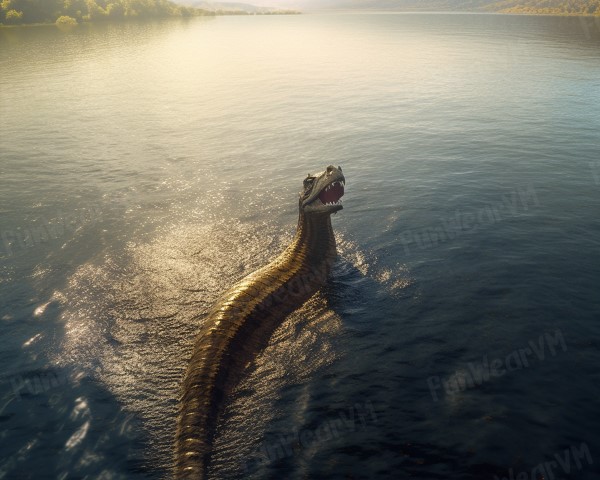
For decades, people have reported seeing a strange, snake-like creature swimming in the bay, sometimes reaching up to 30 feet in length. This creature has been nicknamed Chessie, and it has become a legend in the region.
What is Chessie?
Chessie is a name given to a sea monster that is said to live in the Chesapeake Bay. Chessie is described as having a long, slender body, with small humps along its back. It has a head that resembles a horse or a snake, and it is usually dark brown or black in color. Chessie moves with a serpentine motion, creating waves on the water surface.
When was Chessie first seen?
The earliest possible sighting of Chessie dates back to 1936, when a military helicopter pilot reported seeing something reptilian and unknown in the water near Bush River. However, the first widely publicized sighting occurred in 1982, when Robert and Karen Frew captured Chessie on video near Kent Island. Their footage showed a brownish object moving side to side like an aquatic snake. The video was aired on television and sparked a wave of interest and curiosity.
How many sightings have there been?
Since then, there have been dozens of sightings of Chessie throughout the Chesapeake Bay and its tributaries. Some of the most notable ones include:
- In 1980, several witnesses saw three smooth, triangular humps on the water near Magothy River.
- In 1980, Rosamond Hayes spotted an unusual creature near Prospect Bay that was “certainly no manatee”.
- In 1997, a creature was seen close to shore near Fort Smallwood Park.
- In 2014, two friends saw Chessie less than 5 feet away from their car near Magothy River. They described it as a snake-like creature 25-30 feet long with a slender football-shaped head.
What could Chessie be?
There are many theories and speculations about what Chessie could be. Some of the most common ones are:
- A manatee: Manatees are marine mammals that occasionally visit the Chesapeake Bay from Florida. They have a gray or brown body, a paddle-shaped tail, and two flippers. They can grow up to 13 feet long and weigh up to 1,300 pounds. However, manatees do not have humps or snake-like heads, and they create smooth footprints on the water as they move.
- A seal: Seals are also marine mammals that can be found in the Chesapeake Bay. They have a sleek body covered with fur, a round head with whiskers, and four flippers. They can grow up to 8 feet long and weigh up to 600 pounds. However, seals do not have humps or snake-like heads either, and they usually do not swim for long distances underwater.
- A sturgeon: Sturgeons are large fish that live in the Chesapeake Bay. They have a bony body covered with scales, a pointed snout with whiskers, and four fins. They can grow up to 14 feet long and weigh up to 800 pounds. However, sturgeons do not have humps or snake-like heads either, and they usually stay near the bottom of the water.
- A mutant eel: Eels are long fish that have a slimy body without scales, a pointed head with teeth, and one long fin along their back. They can grow up to 6 feet long and weigh up to 20 pounds. Some people believe that Chessie could be an eel that has mutated due to pollution or radiation in the bay.
- A prehistoric reptile: Some people believe that Chessie could be a surviving member of an ancient group of reptiles that lived in the oceans millions of years ago. These reptiles include plesiosaurs, mosasaurs, and sea serpents. They had long necks, large heads, sharp teeth, and four flippers or paddles. They could grow up to 50 feet long and weigh up to 50 tons.
Why is Chessie important?
Chessie is more than just a sea monster. Chessie is also an environmental icon that represents the health and beauty of the Chesapeake Bay. In 1986, the U.S. Fish and Wildlife Service published an educational coloring book called “Chessie: A Chesapeake Bay Story”. The book tells the story of Chessie as a friendly creature that loves the bay and its wildlife. The book also teaches children about the importance of protecting the bay from pollution and overfishing. A second coloring book called “Chessie Returns” was published in 1991.
Chessie has also inspired many artists, writers, musicians, and filmmakers who have used Chessie as a symbol of creativity and mystery. Chessie has appeared in books, songs, movies, comics, games, sculptures, murals, festivals, and more.
How can you see Chessie?
If you want to see Chessie for yourself, you will need some luck and patience. Chessie is very elusive and shy, and does not show itself often. However, you can increase your chances by following these tips:
- Visit the Chesapeake Bay during spring or summer when the water is warmer.
- Go to places where Chessie has been seen before such as Kent Island or Magothy River.
- Use binoculars or cameras to scan the water surface for any signs of movement or waves.
- Be quiet and respectful so you do not scare Chessie away.
- If you see Chessie, do not approach it or try to touch it. Keep your distance and enjoy the sight.
References:
- https://en.wikipedia.org/wiki/Chessie_%28sea_monster%29
- https://www.chesapeakeconservation.org/chessie-the-chesapeake-bay-sea-monster/
- https://www.wikiwand.com/en/Chessie_%28sea_monster%29
- https://en.wikipedia.org/wiki/Chessie_%28sea_monster%29
- https://en.wikipedia.org/wiki/Manatee
- https://www.fws.gov/chesapeakebay/chessbk.html
